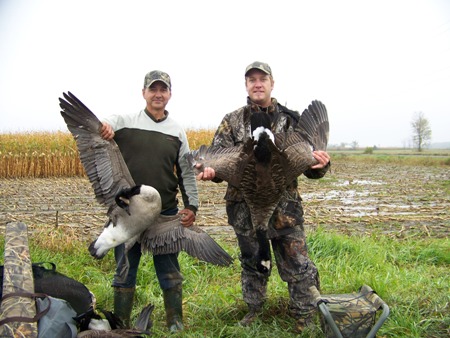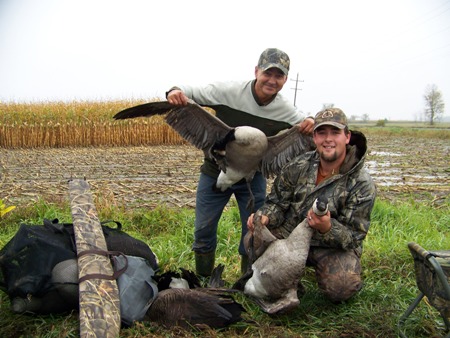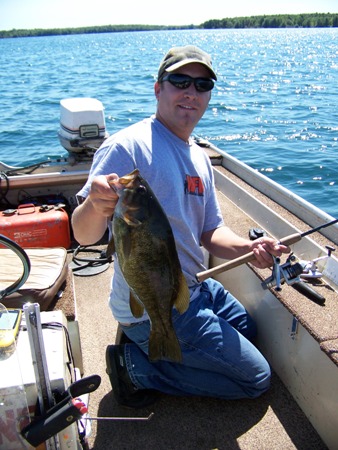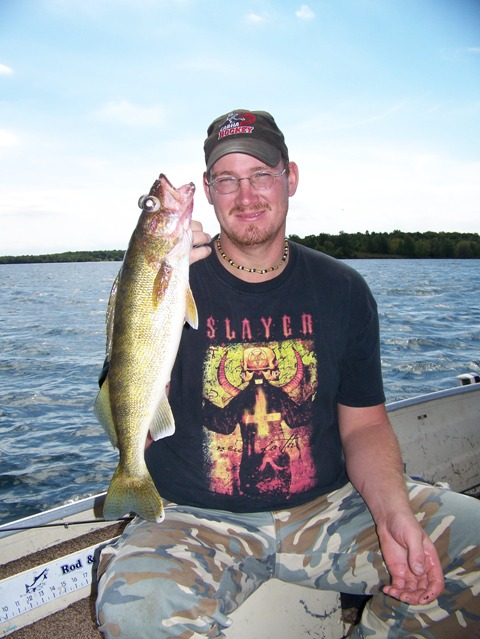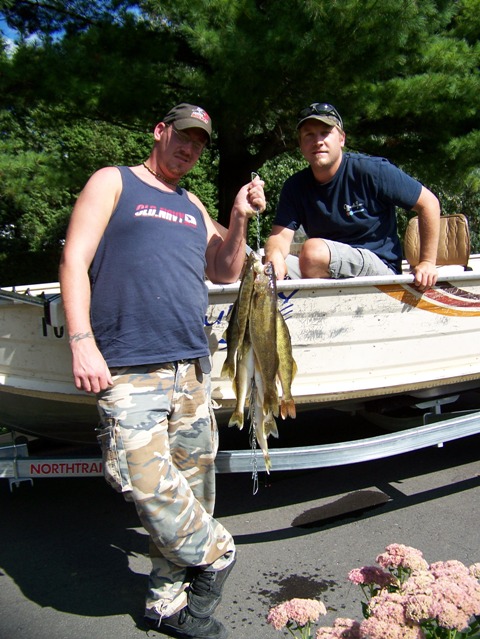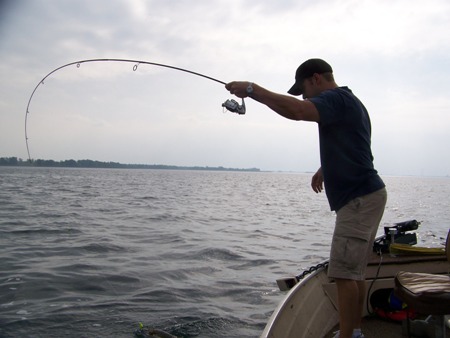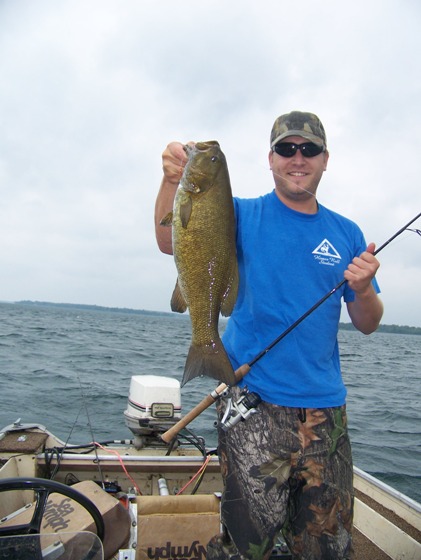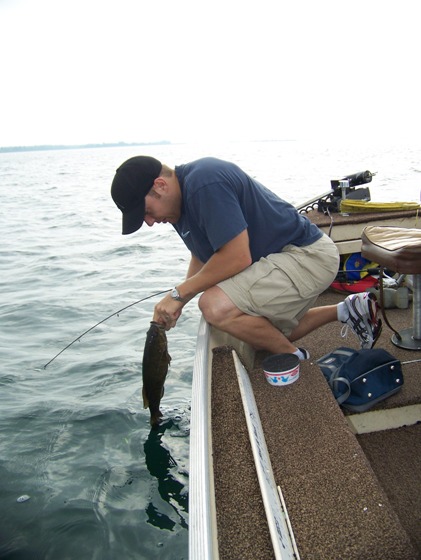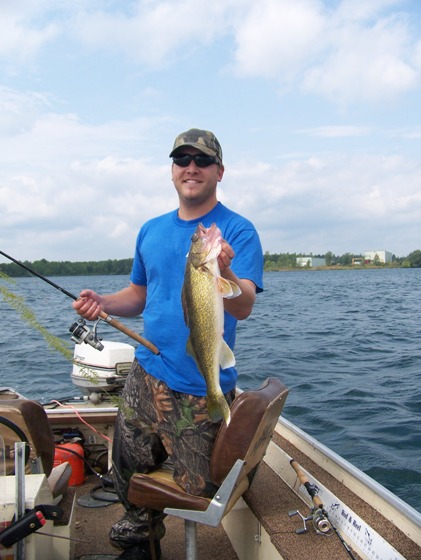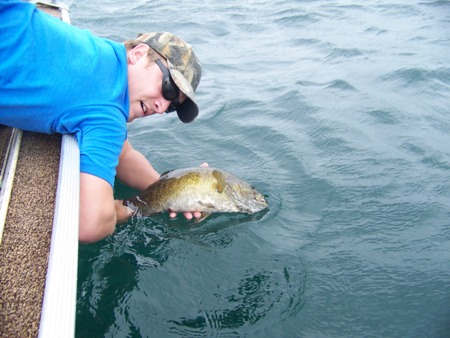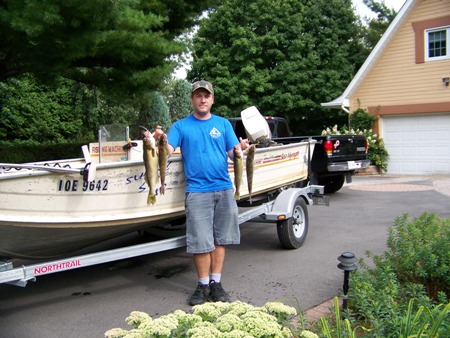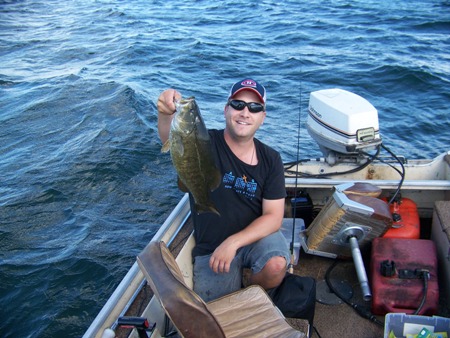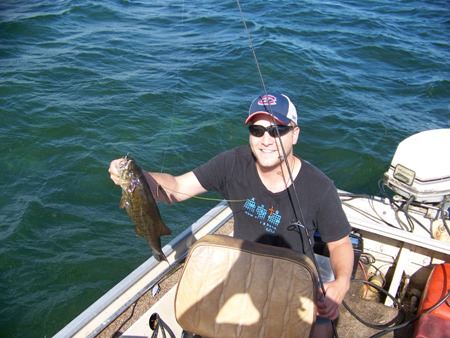Well, it’s been a while. I see some people have visited so I thought I’d send an update from Lake St-Francis. I’ve been perch fishing for the entire months of June and July for the most part. I caught a few small walleye near sheep island (thanks Marc) and further downstream near St-Anicet but they are tough to catch and for the most part they are eating sized fish. If you’re looking for trophies, at this time of year the bass are king out there. Both smallies and largemouths. And if the deep water intimidates you, or you feel like you don’t know where to start, think shallow.
I threw some senkos at largemouths at the stumps with my buddy Jay for an evening in June and they hit us hard. Rigged “wacky style” (see pic below), the Senkos and Yum Dingers thrown with long casts into shore under sunken logs and overhanging trees were irresistible for the large St-Francis bucket-mouths. I have to say, I don’t usually push a particular product but if you haven’t thrown these at your bass holes yet give it a shot. They are fantastic. First of they cast easily because they have a nice bulky composition and are easy to cast at long distances. This is absolutely essential in the clear, busy summer waters of this body of water. You can’t let your presence be known. If the bass know you’re there they won’t bite. Secondly, rigged with a simple #6 or #4 weedless bait hook, they sink very slowly and look like a worm or something that fell out of a tree that is unable to swim to get away. I would say they sink in the order of 2 or 3 inches per second. If you want to work the bait a bit deeper you can always add a small split shot to the shank of the hook. These also shine on slip bobbers. It allows you to work every possible depth and to leave a bait “hanging” in front of bass for a long time. In the right conditions, if your approach is stealthy enough, they can’t resist. A few light “twitches” is all you need to work these things. Don’t give in to the urge of overdoing it. Fish it like as if it were live bait. Unfortunately I didn’t bring my camera that time at the stumps because we only decided to give this a shot on a whim. The largest fish was probably pushing 4lbs and I caught about 5 or 6 of them in one drift of about 200 feet.

I did bring my camera yesterday though on a shoal with the largest concentration of HUGE smallmouth I’ve ever seen. Bar none. This place is unreal and these guys attack anything that looks small and had the unfortunate mishap of drifting into their territory. The ones here are not the biggest in the school by a long-shot. I caught two back to back 21 inchers the night before. This one is about 20. The other two are from a double header my friend Pat and I got into. Smaller fish, but for a 29C blue-skied afternoon, we couldn’t ask for much better.
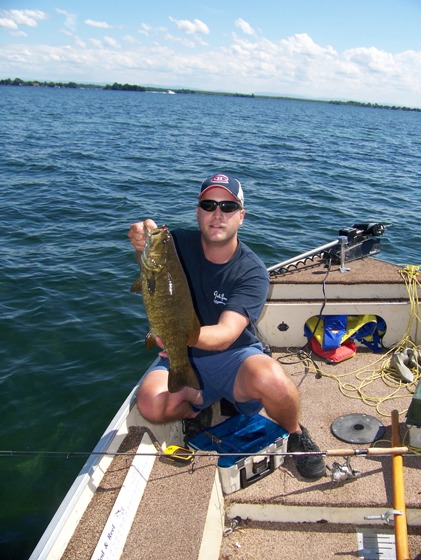
So the story is :
I went out for a walleye hunt near Sheep Island in the early part of the season and on my way there just before hitting the East Light I saw a really big smallmouth cruising in the shallows near a big drop-off. I decided to mark the spot on the GPS and keep it in the memory bank for a place to check out with the masks and snorkels later on in the summer. The weather, as you all are well aware I’m sure, hasn’t exactly been a walk in the park so far this summer. However the last few weeks have been decent so I’ve recently been able to explore the shallows with a mask. My buddy Eric and I headed out there on Thursday and it didn’t take long before the boat was literally surrounded by smallies. I dropped the anchor, put on my flippers, mask and snorkel and jumped in. I immediately saw a smallmouth nearing the 5 pound range come right up to me and size me up. He looked like he was trying to figure out what the heck I was doing. Little did he know, I was scoping the edges of their territory to see where their dining room was. As usual, I also saw a bunch of eels. The bass follow the eels around, and I mean follow. Sometimes two or three fish will hang almost vertically, face down, just behind an eel digging into the rocks and weed clumps. Every now and then, a critter tries to make a quick escape, usually a crawfish, and the bass virtually fight each other for it. They are REALLY aggressive. If you limit your hand movement and get down to the bottom with them you can just about touch them. We swam around and watched, and we outlined the edges of their territory. I carefully noted the edges on the GPS and I made a visual map of the area in my mind so that when I returned in hunting mode, I would make sure that I would not drift right over the spot and spook the fish. As many of you know, boat control is #1 in fishing. Especially in shallow, clear water. This method of prospecting the area underwater first is an undeniable advantage. It allows be to throw finesse baits in the exact spot and to position the boat as far away as possible so as to no spook the fish. Think : sneak-attack. What I like to do is quietly paddle in from a distance and anchor in key strategic positions Instead of buzzing around the entire area with the trolling motor and throwing spinnerbaits looking for fish. That will work too, but If you do your homework and go snorkelling out there the day before you’ll know exactly where they hang out. I cut to the chase, get right in the zone and throw senkos, tube jigs, and plastic crawfish immitations right in the honey-hole. You usually get a fish on your first or second cast. And if you want a guaranteed double-header, throw a rattlin’ rap or another one of those types of fast moving swim-baits just behind the first bass that hit right away. You will get a double-header every time. This type of fishing reminds me a lot of watching those guys on TV land bonefish on the shallow flats of Florida. It’s absolutely electrifying and the payoffs can be huge. Just one thing, make sure you’re using good equipment. These fish are like tanks. I like a 6’6†Quantum Tour Edition Spinning Rod with a fast action and plenty of backbone. This gives me the long casting ability and the comfort of being able to control the fish. I load it with 10lbs test Fireline and a 15 foot fluorocarbon leader tied on to the Fireline with a double UNI-knot. These fish will surprise you with their runs once you get them close to the boat. And you are almost guaranteed acrobatics when they first realize they’re hooked.
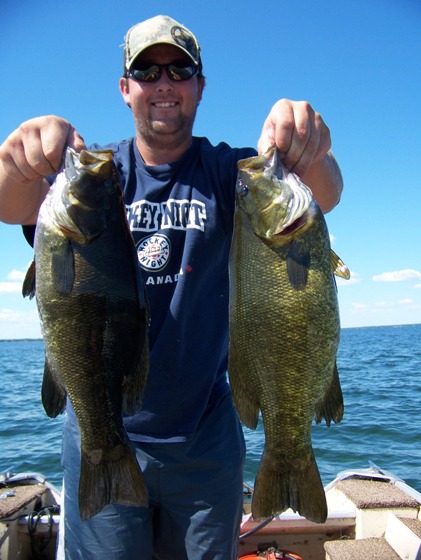
So the next time you’re sitting on shore on a lazy Sunday afternoon in July and you think nothing will bite, stop watching the kids cruising out there on their Bajas and find yourself your own little piece of heaven. These shoals can be tough to find, but once you know it’s there, it will be productive for years to come. Here’s a hint, look for an area with a pile of rocks in shallow water, often shallow enough to hit with a motor, adjacent to a hard sandy and flat bottom, surrounded by week beds and with access to deep water. Get out there with a mask and check the place out, then come back with the arsenal. You’ll have a blast.
Tight lines, Jigger.

